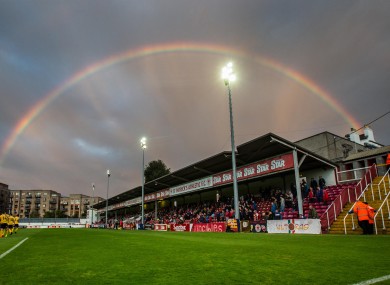
This paper is particularly timely given current debates within the league and the Irish football community generally on the contents of the Conroy Report on the sustainability of the league. The paper is a very welcome contribution to the Irish sports economics literature. This is the first paper of which I am aware that conducts such a robust analysis of the determinants of demand for the league. This might primarily due to data limitations, with attendance figures for the league only recently being available more generally and being somewhat reliable. It is notable that the attendance data (sourced from extratime.ie) are, for some clubs, estimates from journalists and others in attendance rather than official club or league records.
The paper structures the determinants of demand around three groups of variables, expected match quality, outcome uncertainty and opportunity costs for supporters. The findings are consistent with studies for lower leagues in England and in general are unsurprising. The evidence though shatters some dearly held myths about League of Ireland attendances. For example, there is a perception that club supporters would tire of games involving the same Dublin teams too frequently in a season, but the paper finds that derbies (in Ireland these are almost completely between Dublin clubs) are strongly positive effects. Also, live TV broadcast of the game (or another game at the same time) has no significant effect on attendance and the weather seems to be irrelevant (either we League of Ireland fans are a hardy bunch or the switch to “summer soccer” has removed the weather as an important effect).
The key findings are that fixture quality, uncertainty of outcome (a better chance of a home win), geographical distance between the teams, recent team performance and seasonal competitive balance have positive effects on match attendance. The paper is comprehensive and should be used to inform decisions on restructuring and reform of the league. The author suggests that there is little evidence from his analysis that an increase in league size in justified and it is hard to disagree – since such a move would necessarily reduce the number of matches that had an important outcome at stake. The striking finding for me from the paper is the importance of outcome uncertainty – where “the perceived certainty of a match outcome adversely affects attendance for matches where the ex ante home win probability is 0.25 or less” (page 504), and particularly that a fifth of matches fall into this category. This is strong evidence against an increase in the size of the Premier Division.
The author however goes on to recommend a “sizeable reduction” in the size of the Premier Division – and I think the case is less convincing here. The author doesn’t indicate what a sizeable reduction would be. Currently the Premier Division has 12 teams and the Conroy Report has recommended a reduction to 10 from the 2017 season. Is there a point after which the size of the Premier Division works against it being a credible competition? Greater match quality is assumed to accrue from a greater concentration of playing talent in fewer clubs and that these clubs would then be of closer quality. This may very well be the case but the semi-professional (or for some clubs amateur) status may work against clubs attracting talent, particularly for provincial clubs. A good player may be indifferent to playing with one of the many Premier Division Dublin or nearby clubs but it is more difficult for provincial clubs to attract the better players from Dublin. In his most recent book, using a different measure, Stefan Szymanski noted that the League of Ireland was the most competitive European league, so this would seem to suggest the status quo is working in terms of competitive balance.
The Conroy Report refers (and the paper also makes passing reference) to having more games where something is at stake. This is not necessarily increased with fewer clubs (although more balanced clubs would likely mean greater uncertainty of outcome for individual games). The Conroy Report suggests having a break in the season where the division splits in two. In a previous post I suggested an MLS-style conference system with play-offs, which would keep clubs interested longer in the season.
Finally, although it is beyond the scope of Barry Reilly’s paper, the question needs to be asked about what the League of Ireland is for. If it is to generate greater interest (measured for example by attendances) then why not exclude clubs that have shown over many years that they cannot generate large crowds. Perhaps this occurs anyway with the loss of clubs like Monaghan United, Sporting Fingal and Dublin City – it is hardly likely that a club like UCD could be run on a commercial basis. However, if the league is intended to provide an outlet at senior level for as many Irish football supporters then a more regional structure is required and would need to be supported. It is relevant to note that only today the Irish Times reports that soccer is the most popular sport in Ireland – though this is hardly visible in attendances at League of Ireland grounds.
It is these questions that need to be answered before the league is reformed once again. The history of League of Ireland reform suggests that tinkering with league size or structure will fail to address medium to long-term sustainability without a fundamental soul-searching about the league among those who run it and care about it. Barry Reilly’s paper is a critical element in the discussions on what changes are needed, as (finally) we can point to evidence on which to base decisions.
 RSS Feed
RSS Feed